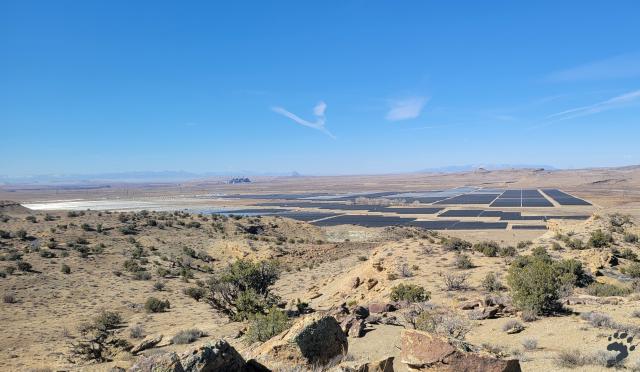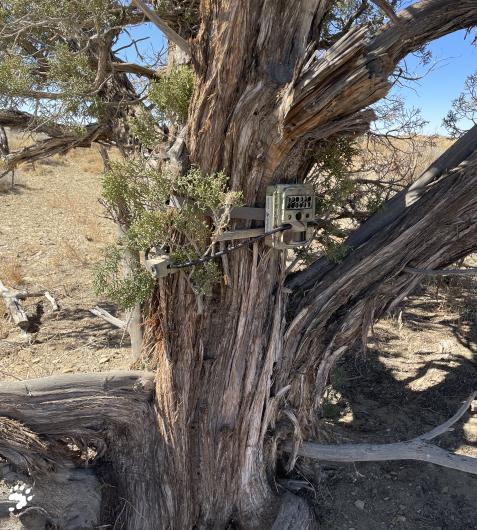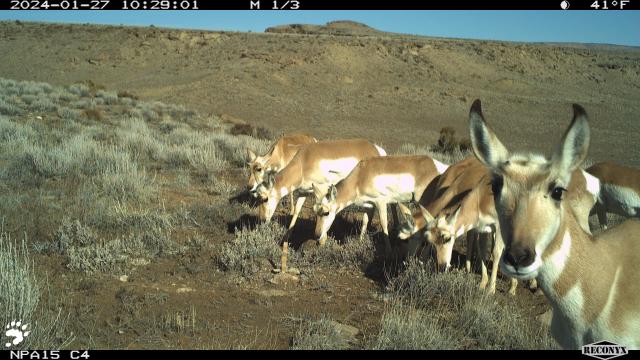You are viewing ARCHIVED content published online before January 20, 2025. Please note that this content is NOT UPDATED, and links may not work. Additionally, any previously issued diversity, equity, inclusion or gender-related guidance on this webpage should be considered rescinded. For current information, visit https://www.blm.gov/blog.
BLM helps conduct groundbreaking research on wildlife and solar development
The Bureau of Land Management, Farmington Field Office, is partnering with Wildlands Network and other important collaborators to conduct groundbreaking research on the impact of solar development on wildlife, specifically pronghorn, in northern New Mexico.
Renewable energy sources like wind and solar are increasing in development all around the country as a means of safe and continuous carbon-neutral alternatives. According to the Department of Energy, more than ten million acres are predicted to be developed for renewable energy in the U.S. by 2050. By last year, $382 billion had already been invested in solar development alone.
Of course, this requires the construction of facilities needed to harness and distribute that energy. The fencing required as part of these facilities is designed to prevent entry by unauthorized humans, but consequently also prevents passage for larger animals. It presents a potentially major barrier to the movements of wildlife. Very little is known about the impact these facilities could have on wildlife herds, such as pronghorn, and their habitats. In the Farmington area, very little is known about the habits of these animals at all.

“Other than what people just see when they’re out there, there’s not a lot of data on herds,” said BLM Wildlife Biologist Ryan McBee. “It’s groundbreaking. There’s not a lot of info here. What’s the population? What do they do? Where do they go?”
Asking similar question was Wildlands Network Senior Wildlife Biologist, Aaron Facka, who grew up in the Farmington area and wanted to know what impact the development of solar energy facilities could have on wildlife. “These pronghorn herds regularly cross a variety of state, federal, Tribal and private lands, which has made it really difficult to both study and manage them. said Facka. “With the pending rapid deployment of solar across all of these jurisdictions, it’s become urgent for us to understand how they’re using the landscape and interacting with these developments so that we can minimize those impacts.”
To address these questions, Facka, along with McBee and collaborators from Navajo Nation, Ute Mountain Ute, New Mexico Department of Game and Fish, and others, secured funding from the U.S. Department of Energy for a four-year study. The goal is to collect data on the effect of solar development on wildlife and provide e that data to agencies and developers, to inform the siting of future projects. This way, developers could factor wildlife considerations into siting and design prior to construction, hopefully mitigating any long-term effects.
To understand these impacts, the BLM,Wildlands Network, and their additional collaborators are using several techniques and technologies to research pronghorn populations, habitat needs and herd movements before and after solar development over the course of four years. Methods include GPS collars, trail cameras, drone surveys and on-site surveys.

Data from GPS collars is uploaded to an internal system, giving researchers real-time information of where herds move and how they interact with solar facilities prior to and after construction. The team also deployed nearly 100 trail cameras to photograph herd movements, which are checked monthly.
“The way solar facilities are constructed, it’s not always just a single block. They often include potential pathways or corridors that wildlife may or may not use,” said Facka. “This gives us a lot of information. Do they use the pathways or do they completely avoid these facilities?”
Once this information is collected and analyzed, it will be used to advise other agencies, land managers and, most importantly, developers. The data can be used when planning construction and facility placement, providing a long-term and efficient method to help design solar developments in a way that proactively addresses these concerns and helps preserve and protect wildlife.

“We can say ‘Hey, this is what we’re looking at,” said McBee. “Maybe there’s a way we can allow for developments to happen while not having significant impacts on wildlife as much as possible.”
Aside from that, this project has also opened up unique opportunities with Tribal partners. As these wildlife populations also roam their lands, those communities have similar considerations. Tribal communities also expect solar development on their lands as a means of renewable power, and they don’t always have the resources to complete this type of research on their own, making them a critical partner in this endeavor.
As of March 1, 2024, 30 GPS collars have been attached to pronghorn in northern New Mexico, and are already providing data, adding to the list of tools land managers are equipped with to manage wildlife.
“We hope to better understand the relationship between wildlife and renewable energy developments on public lands,” said McBee.”
Photos provided by Wildlands Network.
Darren Scott, Public Affairs Specialist
Related Stories
- Progress on Public Lands: BLM 2025 Trump Administration Accomplishments | January 20 - December 31, 2025
- Popular posts: BLM's most viewed blogs of 2025
- BLM delivers on administration priorities
- State of New Mexico officials honor BLM firefighters for Camp Fire response
- Building for birds: Scouts support public lands
